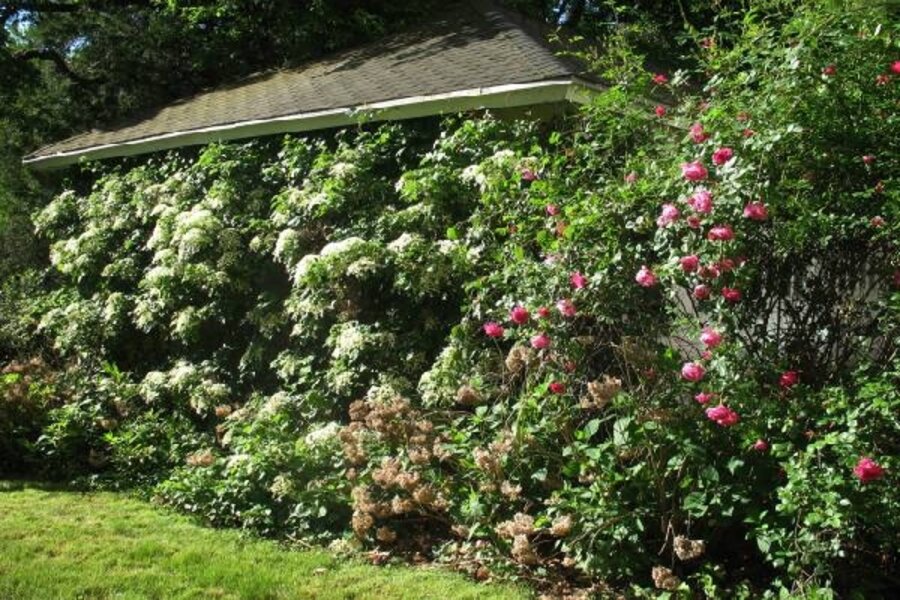The carefree climbing hydrangea: a tale of patience
Loading...
For about 15 years, a big yellow garage marked the south boundary of our backyard garden. It set off the blue bigleaf hydrangeas very nicely, but it wasn't exactly the look we wanted.
The garage is still there, but you can't see it anymore. Nine years ago I planted a single climbing hydrangea a couple of feet from the base of the garage, and after a slow start, it has almost completely covered the wall.
It might be the single most useful plant on the property. On the north side of a building, often a difficult gardening spot, it provides four-season interest and a breathtaking early summer floral display.
Combined with the holly hedge that runs along our east boundary, the climbing hydrangea brings something of a "Secret Garden" feel to its corner, a lost-in-leafiness mood that is only heightened by the droning of bees. And it can be spectacular even at night, if the flowers catch the moonlight.
The vine is nearly care-free. It gets time-release fertilizer granules in early spring and late-summer, and it has to be watered during summer drought. (Our climbing hydrangea has never shown the tendency to wilt on hot afternoons that other hydrangeas have, maybe because it's always in the shade.) I keep it pruned to the top of the wall for fear it will push the roof off, and when I remember I cut it away from the garage windows.
No trellis or wires are needed for support, as the vine adheres directly to the wall.
In spring, handsome, serrated leaves seem to pop from the tracery of reddish-brown stems that permanently adhere to the wall. As they multiply, branches grow out from the wall as much as 2-1/2 feet, giving the vine a three-dimensional heft.
In late spring and early summer, lacy white flower clusters appear. Each bears tiny fertile buds surrounded by a few larger sepals. Although, at 8 or 9 inches, they are as big around as the mophead flowers on some more familiar hydrangeas, the architecture is refreshingly different.
The flowers begin to darken after a couple of weeks, but remain a bright contrast against the dark green foliage for a month.
Eventually, they dry to a tan color and can be pruned off.
(I confess I sometimes leave that task to the next spring. No harm done, and I've seen birds nip off some of the airy dried flowers, perhaps for nesting material.)
In fall, the climbing hydrangea's leaves brighten with yellow.
Some turn color completely while others retain some green and remain an interesting two-tone until they drop off.
When the leaves are on the ground, the plant's spidery outline remains fixed to the garage wall, an interesting wintertime web. The bark exfoliates a bit, too, and gets a bit more reddish.
That's a lot of interest from a single plant, which is said to flourish in USDA zones 4 through 7 or 8. I've seen no bug or disease problems, but the climbing hydrangea (Hydrangea anomala petiolaris) does have one negative — its slow takeoff.
When I first heard about this plant, I was warned that it followed the rhyme often applied to perennials — "sleep, creep, leap." That implied I would see little growth at all the first year and just a bit the second year before the climbing hydrangea took off.
But to be honest, for me it was more like "sleep, sleep, creep, creep, leap." The vine did not show any of its astonishing spreading potential until its fifth year, and it did not flower until its sixth.
Perhaps it was doing all its growing underground, investing in the root system that makes it such a winner today.
So you may not want to try this climber unless you're going to be working the same garden half a decade from now. But if you are, prepare for your patience to be amply rewarded.
I'm thinking about trying to grow one up a big oak tree. It can climb 80 feet, the reference books say, and that would be a sight. If I live long enough.
Editor’s note: Here’s more about gardening: The main Monitor gardening page. Our blog archive. Our RSS feed.
You may also want to visit Gardening With the Monitor on Flickr. If you join the group (it’s free), you can upload your garden photos (and possibly win a prize). Join the discussions and get answers to your gardening questions.
And finally, you can now follow us on Twitter.


